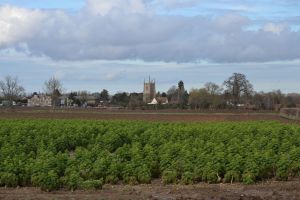Today was the latest of its kind when I just needed to go somewhere, but on this occasion not too far. Upon scanning RBA I elected to experience my third Little Bunting, a wintering bird at a site near Bedford. My first record of this taiga breeder was at close quarters from a hide at a LNR in Cardiff (Feb 2015 – see here). Then earlier this year I stood in line with Oxon’s finest at a feeding station near Chipping Norton in the north of God’s own county to gain what was a county tick for myself as well as quite a few other people.
Working a late shift immediately following a sleepless night two days ago had taken their toll. But on struggling out of bed mid-morning I at once felt that a little cleansing of the system would be beneficial. And so I headed for the village of Great Barford, just 60 miles from home and parked beside a church near Barford Bridge (TF134516). Two other birders returning to their own car said the LB was coming to seed a short walk to the south-west, just before a green metal bridge where the Ouse Valley Way crosses that river.

Great Barford from the riverside site
Upon reaching the described spot at 2:30pm I found a carrier bag containing bird seed on the ground and took the liberty of spreading a small amount on the path ahead of me. I soon realised that hadn’t really been necessary. Numbers of Chaffinch, Reed Bunting and other small passerines were moving about in a thicket to one side of the track (pictured below, right) and coming down to feed on much more seed that had been put down at the edge of a ploughed field. Amongst them before too very long was the Little Bunting.
I was the only person present and spent the next 40 minutes puzzling over various female Reed Buntings. Then a second birder arrived. Whilst appreciating he knew what he was talking about, it had been pleasant enough to be free of plumage topology conversation in the interval and irritating when he put the doubts in as to my own sighting. I now needed to see this bird again to reassure myself and that happened twice more, the first time under this other birder’s direction before he left.
By now two more local birders had arrived and eventually what was needed transpired: a nailed-on, self-identfied repeat sighting. Like so many small (or indeed not so small) birds, when this one appeared it stood out clearly and some diagnostic features were obvious. The head pattern can be variable in tone but this individual’s chestnut facial features were noticeably bright. The other stand out feature for me was very marked streaking of the bird’s flanks. As ever I am not a great one for plumage topography, which is perhaps just as well since the Helm guide to confusion species devotes the best part of a page to it for Little Bunting. Unfortunately I did not manage to get a photograph, but the couple with whom I observed today’s bird sent me this excellent video.
Great Barford Little Bunting – courtesy of Peter and Kathy Blackmore
Though sporadic in it’s appearences during my two hours on site here today’s Little Bunting provided good value. The Cardiff bird had been viewed mostly into bright sunlight and the north-Oxon one was somehow difficult to appreciate in such a large gathering. So of my three records to date this is the one that has told me the most about a regular winter visitor. And though I regard baiting birds with seed as contrived, today’s encounter aptly illustrates how difficult it would be to locate those many scarce passerines that go unseen in the British countryside were it not for feeding stations such as this.
Footnote: Having not got a photograph I returned a day later to try again, but waited three hours from 12 to 3pm even to see this bird. Various local birders came and went in that time and conveyed that this Little Bunting is often elusive. It was first found by a surveyor before Christmas, and after Beds county listers spent a lot of time here without success the county bird recorder authorised the bag of seed to make things easier. So this site is not a permanent feeding station like the one in north Oxon.


